Introduction. In the Polish tradition national parks are considered to be the most important and best form of protection as far as the whole of nature is concerned. Polish law secures the high status of protection. According to the 1991 nature conservation act (art.14.1): "The National Park embraces the protected area outstanding for its particular scientific, natural, social, cultural, educational values of the area not smaller than 1000ha in which the whole of nature and some of the landscape features are protected." The most important aims of parks are - the preservation of natural systems and re-naturalisation of destroyed natural systems. At the same time national parks are under intensive pressure from tourism.
In this paper a trial has been made to estimate (by means of a survey) the aesthetic quality of landscapes of the chosen national parks. The gathered data were compared with the results of natural valorisation carried out in the Institute of Nature Conservation [2]. The research carried out should give answers to the following questions: According to Poles, which of the parks are the most valuable and the most attractive? To what extent the perception of national parks is connected with the individual features of the person questioned? To what degree the estimation made by the people questioned agree with the valorisation of nature. The knowledge of the aesthetic preferences of Poles concerning the nature and landscape of our national parks can give us the information of the real or potential tourism pressure on the area environment.
The research on landscape quality. The landscape is valued as a synthesis of integrated perceptions of views and different sensual feelings as well as proper associations and structures encoded in the observers' mind. In every process of landscape perception there is an association with the information received through the senses and the information culturally filtered [13]. The aesthetic landscape estimation is a derivative of its perception. It constitutes a very complicated and difficult process because of the limits of objective value measurement. The visual landscape attractiveness influences the activities, especially tourists and recreational [6].
Among the methods and techniques commonly used in the research over landscape perception are: a survey research and a research of landscape preferences mainly with the use of photographs of landscapes. Often these two methods are combined. In the research of aesthetics of the landscape, particular attention was paid to the sense of eyesight and its aesthetic value and to a lesser degree to the remaining senses [6, 10].
It is impossible to work out an objective estimation of aesthetic landscape values, because there are no objective patterns of beauty and because of the enormous diversity of landscapes. The result of the estimation of landscape attractiveness depends on the estimating person (his or her sensitivity, culture, education, and personal attitude towards the area) and local terrain situation. The considerable influence of human personality on the estimation, makes some of the researchers consider "landscape quality" not as an element of physical landscape but as the effects of processes taking place in the observer's mind [7].
Such an attitude is a base of the research over "scenic landscape assessment", in which often for research purposes photographs are used in the landscape estimation instead of real landscape [14, 4, 1]. The method is commonly used in the landscape research, but still it causes much doubt. Palmer and Hoffman [5] point to some of them. For example: How many pictures are needed to show specific features of different landscapes? How the sequence of picture presentation influences the estimation? Is the result of estimation the same in a year or in ten years time?
The estimation of landscape quality on the basis of its visual values is sometimes criticised [3]. The term "landscape aesthetics" is opposed to "ecological aesthetics", assuming ecosystems feature (biodiversity) as the most important value in landscape estimation. Evaluation based on the visual criteria is considered to be intellectually shallow.
The most proper attitude seems to be the one based on comparison and integration between aesthetic end ecological assessments. Such attitude is presented below. The environmental value of national parks cannot be disputed, but the way it is going to be perceived by potential and real tourists will to a large extent influence its future.
Research method. The research of landscape perception of Polish National Parks was carried out by means of an Internet survey. It consisted of the assessment of 21 not described photos and answers for 5 questions. The Internet as the source for collecting data has advantages as well as disadvantages. The advantages are: the speed of collecting data, anonymity, the possibility of approaching a vast number of people, reduced costs of the survey. The major disadvantage is the representativness of the collected data. Despite a dynamic increase in the number of people using the Internet most of them are still young, well educated, living in big cities. That is why the received information is not representative for the whole society.
The researched landscape of 7 national parks was assessed on the basis of 21 pictures (each park was represented by 3 photographs). The photographs were chosen by authors from the wide set of pictures. The following criteria were used to select the photographs: a characteristic, distant landscapes, the photographs were to represent high but similar technical and artistic levels, all pictures were taken in the period from spring to early autumn (Tab. 1).
Table 1. The characteristics of landscapes estimated in the survey.
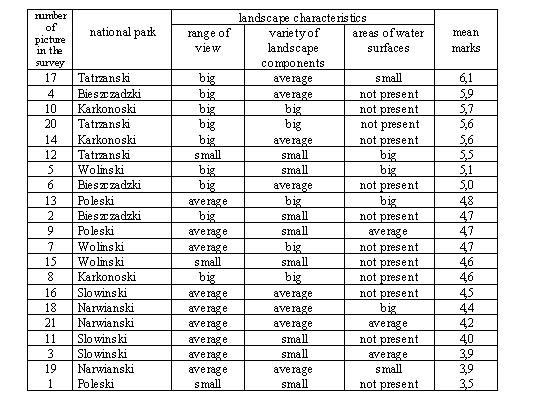
The inquired Internet users assessed every landscape (photo) in a 7-point scale: 7 points (very interesting)...1- point (uninteresting). The landscapes were assessed in a set sequence, without the possibility of changing the assessment already made. Additional questions and a personal questionnaire were at the end of the inquiry. The questions concerned the assessment of value and attractiveness of Polish national parks. In the questionnaire the information of sex, age, education, and place of residence was given.
The message with the appeal to fill the survey was sent to 30 Internet newsgroups. About 50% were the regional lists, the rest belongs to the Internet domain "pl.rec" (recreation). The Internet users were asked to fill out the survey that was worked out for the purpose of a scientific article. They were not informed about the particular aim of the survey nor the area it concerns. The surveys were gathered for six days. 1016 surveys were gathered all together (more than 21 000 landscape assessments).
The study area comprised 7 national parks representing different types of polish landscapes: 3 mountain parks, 2 lowlands, 2 seaside ones (Fig. 1). The examined parks despite big landscape diversification differed considerably in their size, age, the area of strict protection and forested area (Tab.2.).
Bieszczadzki National Park comprises the highest part of the western Bieszczady Mountains. One of the characteristic elements of the park's environment is the level of mountain pasture ranging from the forest border to the highest summits (> 1300m a.s.l.). The mountain pasture ridges are diversified by the presence of crests relict rocks.
Tatrzanski National Park is located in the western Carpathian Mountains and comprises their highest massif - Tatra Mountains (up to 2499m asl). It is the only characteristically Alpine landscape in Poland. The Tatra Mountains differ from other Polish mountains in their sharp, jagged crests and summits. The Tatrzanski NP is characterised by an alpine climate and layered arrangement of flora.
Karkonosze National Park is located in the northern part of the Karkonosze Mountains the highest part of Sudety Mountains (up to 1600m a.s.l.). A feature that makes these mountains different from other mountains in Poland is a unique landscape shaped by granite magma intrusions in Carbon and by Quaternary glaciations. Numerous granite island mountains are typical of the Karkonosze landscape.
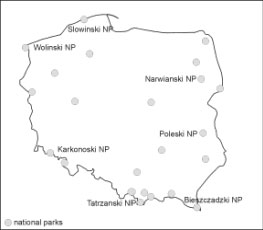
Fig. 1. Studied areas against the Polish National Parks system
Table 2. The researched parks characteristics (after [12])
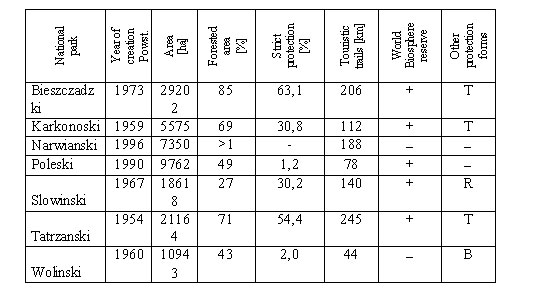
T - Transborder Protected Area
B - Convention on the Protection of the Marine Environment of the Baltic Sea Area
R - Ramsar Convention on Wetlands
Slowinski National Park is located on the mid coast and occupies a vast number of seaside dunes. Some of them are forested and some are moving dunes the so-called white dunes. It creates a unique desert landscape in Europe. Moreover within the park's borders there are huge coastal lakes: Lebsko and Gardno as well as a few smaller ones with peatbogs and marshes.
Wolinski National Park occupies the most naturally valuable part of the Wolin Island. Moraine hills, appeared during Baltic Glaciation, are characteristic of the terrain relief. Their height reaches 115m a.s.l. and they fall to the sea with 90m steep cliffs. Within the parks borders there are also seaside dunes and post-glacial lakes.
Poleski National Park is a lowland park, which represents Lublin Polesie. It comprises the biggest fragment of marshes in Europe, peatbogs, meadows and lowland Karst lakes. The area is characterised by a high degree of naturalness and is unique in European ecological systems. They are created by genetically and morphologically diversified vast peatbogs, marshes, small and shallow eutrophic and distrophic lakes as well as various forest systems.
Narwianski National Park comprises a fragment of naturally formed valley of the upper Narew River. The Narew River valley within the park area is characterized by a developed system of river channels creating a system of branches, old riverbeds and overflow lands. Hydrological and geomorphological conditions of the Narew River valley caused the creation of a very diverse water system, water-meadow, land-marsh and land environments.
Results. Among the people surveyed males were in the majority - 81% of people, between 20 - 35 years old (73%), of higher education (57%) most of the respondents came from Mazowieckie Voivodship (18%), Malopolskie (12%), Slaskie (12%). Less than 5% of the respondents declared basic education. The smallest number (1%) of respondents came from Swietokrzyskie, Opolskie, Lubuskie voivodships. Respondents who visited from 4 to 10 National Parks were in majority (60%); 21% visited from 1 to 3 National Parks and (18%) visited more than 10 parks
The people questioned gave high marks to the presented landscapes - 64% gave 5, 6 and 7 marks (Fig. 2). All of the presented photographs were marked above 3.5 (average mark). In 71% of cases the average landscape marks given by females were higher than the marks given by males (Fig. 2). The most visible differences (up to 10%) appear in the case of Slowinski NP, which got higher, marks from females (4.4 and 4.9) as compared with males (3.8 and 4.5). Females gave higher marks also to the landscapes of Wolinski NP - delta of Swina river and beech wood. The marks given by females were less diversified than the ones given by males (standard deviation 0.7 to 1.1 respectively).
The landscape order (5 with highest marks) according to (picture numbers in Tab.1)
females: no. 17 (6.3), no. 4 (6.0), no 10, 12, 20 (5.7)
males: no. 17 (6.1), no. 4 (5.9), no 10, 14, 20 (5.6)

Fig. 2. The results of landscape assessment on the basis of 21 photographs
(F - females, M - males).
The higher the knowledge of Polish National Parks, the higher marks given to the particular landscapes on the basis of the presented photographs. In 11 cases people who visited more than 10 parks gave the highest marks. The people who gave the lowest marks to the presented landscapes visited from 1 to 3 national parks (13 cases).
The synthetic landscape attractiveness of all analysed parks was highly assessed - the lowest average mark was 4.2 (Fig. 3). The people surveyed gave the highest marks to the mountain parks landscape - they occupy the first three places (the average mark was more than 5.3). Slowinski NP (4.2) and Narwianski NP (4.2) got the worst results. Among the three best landscapes there was one from Tatrzanski NP (6.1), Karkonoski NP (5.9) and one of Bieszczadzki NP (5.6). The landscapes with the lowest marks were: peatbogs in Poleski NP (3.4), beaches in Slowinski NP - (3.9), Narew river valley in Narwianski NP (3.9).
The following regularities were found in the analysis of the influence of habitation on the assessment of landscape values:
- the landscape of Tatrzanski NP was assessed as the most interesting in all 16 voivodships; especially among the inhabitants of southern provinces: Opolskie (6.4), Podkarpackie (6.2), Slaskie and Dolnoslaskie (5.9) and also the northern ones: Warminsko-Mazurskie (6.3) and Zachodniopomorskie (5.9);
- in 11 voivodships Karkonoski NP takes second place (5.2-5.8) in the remaining ones it is Bieszczadzki NP (5.0-5.3) that takes the second position;
- Slowinski NP (8 voivodships: 4.0-4.3) and Narwianski NP (8 voivodships: 4.1-4.2) got the lowest marks. People from Podlaskie voivodship (4.4) from Swietokrzyskie voivodship (4.8) put the landscape of Narwianski NP on 5th place; however Slowinski NP got higher marks among the people surveyed from Pomorskie voivodship (4.4), opolskie (4.3) and Malopolskie (4.4).
![The results of synthetic assessment of national parks' landscape on the basis of photographs - average values [F- females, M - males]](http://i-kar-100.narod.ru/referatu/001/001/08-05.jpg)
Fig. 3. The results of synthetic assessment of national parks' landscape on the basis of photographs - average values [F- females, M - males].
The people were also asked to choose maximum 3 parks, which from their point of view are the most valuable ones. 533 people (52%) pointed to Tatrzanski NP, Bialowieski NP was second (399 people) Biebrzanski NP was third (276 people) and Bieszczadzki was fourth (263 people). At the other end of the scale there were Wielkopolski NP (chosen only by 6 people), Magurski (10 people), Poleski, Gorczanski and Drawienski (14 people). Somewhat different results were gathered where people had to choose the most beautiful parks: again Tatrzanski NP took the first place (54%) than Bieszczadzki (36%), Ojcowski (17%), Pieninski, Gory Stolowe NP and Biebrzanski (16% each). There is clear domination of mountainous parks. The lowland parks got the worst results: Ujscie Warty (2%), Kampinoski (2%), Wielkopolski and Poleski (about 1%).
The inhabitants of all the voivodships pointed to 4 parks as the most valuable ones: Tatrzanski, Bialowieski, Bieszczadzki, Biebrzanski NP. However in the case of parks' attractiveness the influence of own experiences or some sort of "local patriotism" could be found. It is particularly conspicuous among the people surveyed from Podkarpackie, Podlaskie, Dolnoslaskie voivodships (Fig. 4). They gave high marks to the national parks situated in their vicinity: Roztoczanski NP (Lubelskie voivodship), Gory Stolowe NP. (Dolnoslaskie), Bory Tucholskie NP (Pomorskie), Ojcowski NP (Malopolskie).
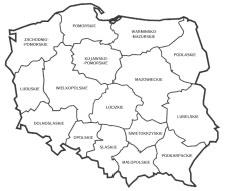
Fig. 4. Map of Polish voivodships
The mountainous landscape got the lowest marks from the inhabitants of Kujawsko-Pomorskie, Lubuskie, Lodzkie and Wielkopolskie voivodships (Table 3). The highest marks it obtained came from people from Warminsko-Mazurskie, Podkarpackie and Opolskie voivodships. The seaside landscape got the highest marks from the inhabitants of Warminsko-Mazurskie and Swietokrzyskie voivodship. The people from Zachodniopomorskie voivodship found it the least interesting. The lowland landscape got marks below average from the respondents from Opolskie and Lubelskie voivodships. In the case of influence of sex on the assessments of landscape types a female tendency presented earlier appears, to give higher marks to the seaside landscapes - the average mark 4.9 as compared with males 4.5.
Tab. 3. The assessment of attractiveness of landscape types according to habitation (selected voivodships)
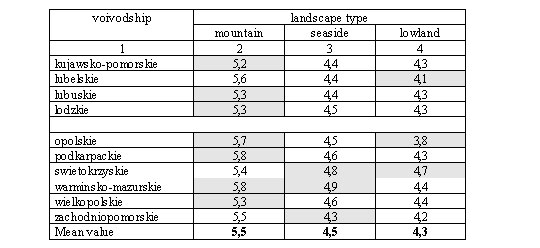
Discussion. All classifications and valorisations, which aim at finding a common denominator of the national parks' features in order to compare their values must be considered as a big simplification. Every Polish National Park is individual and unique and protects valuable natural resources of our country. The presented survey shows only preferences concerning the discussed issues among the surveyed Internet users. The general assessment of landscape values as well as their attractiveness and national parks' value is coherent with the natural valorisation of Polish National Parks carried out by Denisiuk (1992) on the basis of 17 criteria (Tab. 4). In all categorisations Tatrzanski NP takes the first place, Bieszczadzki NP receives high marks (2 - 4 place), Karkonoski NP is a bit worse (2 - 9 place). The highest divergence appears in the case of Slowinski NP. By the people surveyed it was assessed low as the landscape values were concerned, was average as far as attractiveness and natural values were concerned. However in natural valorisation it is placed considerably high (6 position). Narwianski NP got the worst marks in all fields.
It is difficult to treat the results as representing the whole of society. The gathered data are true for the group of young, active people with higher education. They are a minority in the Polish society, however they are the most committed and influential group as well as the one frequently visiting national parks. Certainly in some cases it was difficult to separate the landscape assessment from the technical and artistic aspects of photographs.
Table 4. Specification of the assessment results of the chosen national parks

assessment of landscape values (on the basis of photographs)[scale1-7]
assessment of national parks' value (survey)[scale 1-23]
assessment of attractiveness of national parks (survey)[scale 1-23]
Natural valorization of national parks (Denisiuk 1992)[scale1-23]
The results concerning the landscape and national park values' preferences of the people surveyed are consistent with the data concerning the intensity of tourism on the park area. The parks highly assessed (Karkonoski. Tatrzanski) are characterised by a high inten-
sity of tourism: 270-120 people/ha respectively [intensity of tourism in 2001 according to the The Board of Polish National Parks]. In the case of lowly assessed parks - Poleski, Narwianski, Slowinski the number of tourists ranges from a few to 20 people/ha.
Conclusions
The landscapes presented on photographs were generally very highly assessed. A few factors are responsible for this: (1) the presented landscapes belong to the most naturally valuable areas of Poland; (2) the photographs presented were of good technical quality and high artistic level.
The people surveyed gave the highest marks to three mountainous parks: Tatrzanski, Karkonoski, Bieszczadzki. The landscapes of Slowinski and Narwianski parks were given the lowest marks. The assessment was irrespective of habitation, sex and age.
There is clear dependency between the assessment of photos and remoteness of view on the picture - the landscapes characterised by a distant view were given the highest marks.
Females always assessed the presented landscapes higher. There is a similar tendency among people who visited more than 10 national parks.
There is high consistence between the opinion of the surveyed people (shaped by photos) and natural value of National Parks. It points to the fact that landscape aesthetics not always must be in opposition to ecological aesthetics Differences appear in the case of Karkonoski NP (high mark in the survey and low mark in natural valorisation) and in the case of Slowinski NP (low marks in the survey, high natural values)
In the surveyed people's opinion the most valuable parks are: Tatrzanski, Biebrzanski, Bialowieski national parks. Such a result must be connected with the level of knowledge of the surveyed people - the information about these parks is often presented in the media.
As for the most beautiful national parks they pointed to: Tatrzanski, Bieszczadzki, Pieninski National Park. In some voivodships the people surveyed gave high marks to the parks in the vicinity of their residence.
High assessment of national parks is consistent with spatial arrangement of tourism in these areas. National Parks with high marks have intensive tourism.
The respondents show deep interest with the survey subject. On various newsgroups there were questions about the accessibility of the survey results. It means that the problem discussed in the paper are not only academic in character.
Literatura
1. Clay G. R., Daniel T. C. Scenic landscape assessment: the effects of land management jurisdiction on public perception of scenic beauty // Landscape and Urban Planning. 2000. No 49.
2. Denisiuk Z. Walory przyrodniczo-krajobrazowe parkow narodowych w Polsce // Parki Narodowe i Rezerwaty Przyrody. 1992. Tom 11. Nr 2, 3.
3. Gobster P.H. An ecological aesthetic for forest landscape management // Landsc. J. 1999. No 18 (1).
4. Hull R. B., Buhyoff G. J. Individual and group reliability of landscape assessments // Landscape Planning. 1984. No 11 (1).
5. Palmer J. F., Hoffman R. E. Rating reliability and representation validity in scenic landscape assessments // Landscape and Urban Planning. 2001. No 54.
6. Pietrzak M. Syntezy krajobrazowe. Zalozenia, problemy, zastosowania. Poznan, 1998.
7. Lothian A. Landscape and the philosophy of aesthetics: is landscape quality inherent in the landscape or in the eye of the beholder // Landscape and Urban Planning. 1999. No 44.
8. Ochrona Polskiej Przyrody / Kaj Romeyko-Hurko (red). 2003. (CD-ROM.)
9. Olaczek R. Ochrona przyrody w Polsce. Warszawa, 1996.
10. Sleszynski P. Percepcja atrakcyjnosci wizualnej krajobrazu okolic Pinczowa. (Perception of visual attractiveness on the Pinczow vicinity) // Przeglad Geograficzny. 2001. No 73 (3).
11. Ustawa z dnia 16 pazdziernika 1991 r. o ochronie przyrody. Tekst jednolity Dziennik Ustaw 99/2001, poz. 1079; z pozn. zm., w szczegolnosci Dziennik Ustaw 100/2001, poz. 1085.
12. Wilgat T. Polskie parki narodowe w liczbach // Annales UMCS, sec. B. 2002. Vol. LVII.
13. Wojciechowski K. H. Problemy percepcji i oceny estetycznej krajobrazu. Lublin, 1984.
14. Zube E. H., Sell J. L., Taylor J. G. Landscape perception: research, application and theory // Landscape Planning. 1982. No 9 (1).